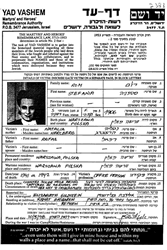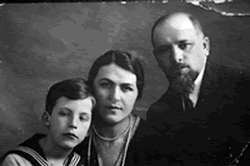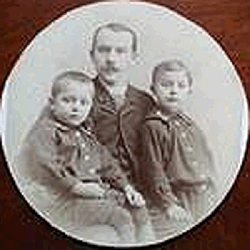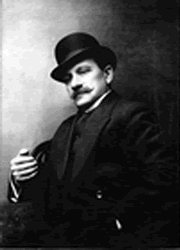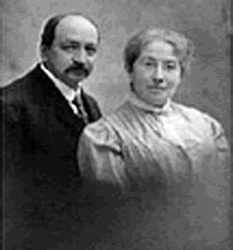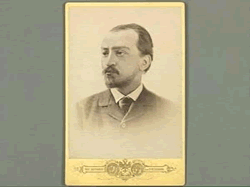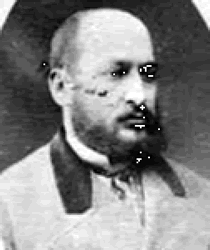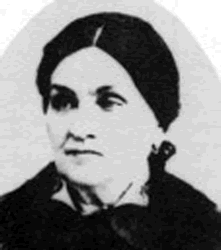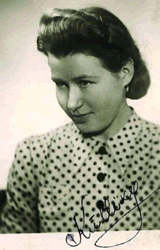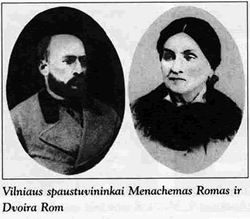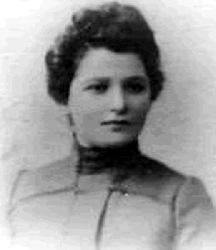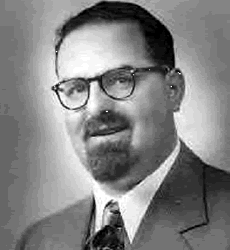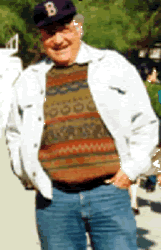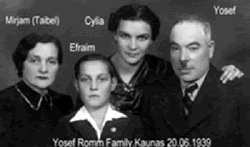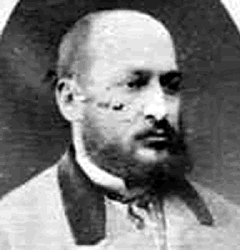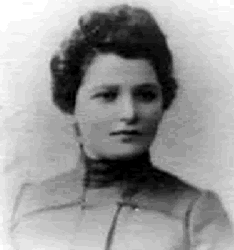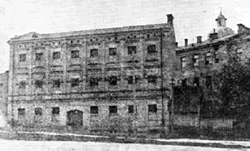#romm-1
Stefania Rom was born in Warszawa, Poland in 1906 to Rafael and
Natalia. She was a clerk and single. Prior to WWII she lived in
Warszawa, Poland. During the war she was in Warszawa, Poland. Stefania
was murdered in 1941 in the Shoah. This information is based on a Page
of Testimony (displayed on left) submitted by her niece.
#romm-2
David Romm 1883-1960 (77)
Son of Matthew (Menashe) Romm and Fanni Romm
Husband of Galina Romm
Father of Michail Romm
Brother of Gregoriy Romm and Jakob Romm
Half brother of Samuel Edward Romm; Lewis Rome; Ann Muriel Rome;
Margery Rome; Billy (Devorah) Rome and 1 other
#romm--3
Dr. Gershon Romm 1855 - 1929 Vilna
Son of David Romm and Dvora Harkavy Romm
#romm-4
Menashe (Matthew) Romm 1856
1936 (80) Son of David Romm and Dvora
#romm-5
Dr. Maxim Romm with his wife Julie
#romm-6
Dr. Maxim Romm
#romm-7
Menachem Man Gavriel Romm (1842- 1910)
Son of Josef Reuven Romm
#romm-8
Gita Harkavy Birth; 1840
Daughter of R' Yosef Bezalel Harkavy and Tzerna-Ita Strashun
Wife of Menachem Man Gavriel Romm
Mother of Dr. Rowan (Rubin) Romm; David Romm; Masha Romm Bloch; Jacob
Romm; Sonia (Sofiya) Romm, Eliyahu Romm; Alexander Romm and Chana
Romm.
Sister of Dvora Harkavy Romm; Rachel (Rashil) Harkavy Konigsberg;
(Vladimir) Zeev Wolf Harkavy; Chana Harkavy Goldovsky; Eliyahu Yehuda
Harkavy and 2 others
Half sister of Badana Gorewitz
#romm-9
Toini Romm
#romm--11
Dvora (nee Harkavy) Romm the wife of David Romm , the publisher.
After his death she took control of the publishing house.
#romm-14
ROMM:
Family of printers and publishers of Hebrew books in Wilna. The family
formerly lived in Grodno, where the book-dealer Baruch son of Joseph
Romm established a printing-office in 1789. The Romm Hebrew
printing-office was the first in Lithuania, and its authorization by
King Stanislaus August was considered an important event. In 1799
Baruch moved to Wilna, where he died April 29, 1803. The business was
inherited by his son Menahem Man Romm, who in 1835 began, in
partnership with Sim?ah Zimel of Grodno, the crowning effort of a
Jewish printer's career—the publication of a new edition of the
Talmud. The first volumes of that edition bear the imprint "Wilna and
Grodno"; the later volumes have that of Wilna only; but the work was
really done in Ozar, near Grodno.
Menahem Romm died Oct. 13, 1841, and was succeeded by his only son,
Joseph Reuben Romm, under whom the printing-house was formally
established in vilna in 1847, although the report of a conflagration
("Allg. Zeit. des Jud." 1840, No. 20) proves that it had even
previously been of considerable size and importance. He died Feb. 28,
1858, and left three sons, David, ?ayyim Jacob (d. Aug. 30, 1869), and
Menahem Gabriel. David, who was the head of the firm, died suddenly
March 9, 1860, while on his way from St. Petersburg, where he had
obtained a practical monopoly of the Hebrew printing and publishing
business in Russia. After his death the monopoly was broken, and
numerous printing establishments sprang up in various parts of the
empire. In 1863 the present firm name, "Witwe und Brüder Romm," was
adopted; and the house has maintained its position as the foremost
Jewish publishing concern in Russia, if not in the world. Deborah
Romm, David's widow, took an active interest in the firm's affairs
until her death on Dec. 3, 1903. Three of her sons reside in New York.
(from the Jewish Encyclopedia)
From The Life and Times of Rabbi Shimon Romm: A Biography
The Commentator
By: Zalman Alpert Issue date: 12/6/04 Section: Yudaica
At a young age, Rabbi Romm lost his father and was sent by his mother to study at the yeshiva in Slonim. Although Slonim is now chiefly remembered for the Weinberg Hasidic dynasty that began there, it was in fact a real Mithnagdic town, with the greatest of Litvishe rabbanim (among them, Rabbi Mordechai Rosenblatt, known as the Oshmener Rav who, besides being a Talmudic giant was also a well known Poel Yeshuoth, the last of the Lithuanian Baalei Mofsim). In Slonim, the young Rabbi Romm studied under the famed Rabbi Shabsi Yagel, and was exposed to the oratorical talents of the communal rav, Rabbi Yehuda Leib Fein HY"D. On numerous occasions, Rabbi Romm spoke of Rabbi Fein's impressive speaking abilities, even referring to him as the greatest rabbinical orator in inter-war Europe. After some time at Slonim, Rabbi Romm studied at the Mussar Yeshiva of Novardok before moving to Kletzk where he studied under the late Rabbi Aharon Kotler, who later came to America to establish the Beth Medrash Govoha and Kollel in Lakewood, New Jersey. Though he was close with Rabbi Kotler, Rabbi Romm never visited the Lakewood Kollel in the United States even while Rabbi Kotler was alive, which I suspect had to do with issues of hashkafa and geographical distance.
Rabbi Romm's final formal yeshiva years were spent in "Da Mir," the best known Yeshiva in Polish Lithuania. Here he studied both under Rabbi Eliezer Yehuda Finkel, (son of Rabbi Nosson Tzvi Finkel, the famed Alter of Slabodka,) and under the rabbi of the town of Mir, Rabbi Avraham Tzvi Hirsch Kamai HY"D, who eventually conferred rabbinic ordination on Shimon Romm.
Despite the impressive list of teachers, Rabbi Romm remarked on several occasions that his "rabbo muvhak" (master teacher) was the 16th century Maharsha - Rabbi Shmuel Eliezer Eidels - a comment very much in tandem with another Lithuania giant, the Chazon Ish [Rabbi Avraham Yeshaya Karelitz] who too bemoaned that modern post-Brisker yeshiva students were no longer steeped in the Maharsha.
Several years prior to the outbreak of the Second World War, Rabbi Romm married Kaila Eisenbod, the daughter of Rabbi Eliyahu Eisenbod of Vashilishok, a small town near Vilna with a strong tradition of Torah scholarship, even in modern times. The "Heiliger Chafetz Chaim," as Rabbi Romm referred to him, had lived in Vashilishok for a while.
When Rabbi Romm informed Rabbi Chaim Ozer Grodzenski, the chairman of the Moetzet Gedolei Hatorah (Council of the Torah Sages) of the Agudath Israel, of his impending marriage to the Vashilishoker Rav's daughter, Reb Chaim Ozer congratulated him and told him that he wished that the Agudah would have such rabbinic members as Rabbi Eisenbod; the Vashilishoker Rav was a known Mizrachi leader. Indeed, it remains a little known fact that many of the Lithuanian rabbis in pre-war Poland were associated with Mizrachi. The Chafetz Chaim's eldest son, Rabbi Yehuda Leib Poupko (who assumed the surname to escape from compulsorily army service) served as president of the Polish Mizrachi for a number of years leading up to 1939.
Following his marriage, Rabbi Romm served as the "Rav Zair," the associate rabbi, of Vashilishok under his father-in-law, thus gaining experience in the fields of pastoral and practical rabbinics. He gave the daily Gemara shiur in the town's largest Beit Midrash. But in 1939, at the outbreak of the war, Rabbi Romm fled Lithuania with his family and the rest of the Mirrer Yeshiva, making their way across the Soviet Union and eventually in Shanghai. While in Shanghai, Rabbi Romm served as a teacher to the already tens of thousands of German Jews living there in addition to continuing studying at the yeshiva.
Yet unlike most of his fellow refugees that went Shanghai, Rabbi Romm managed to leave prior to the conclusion of the war. In 1942, together with a small group of Jews from Shanghai, Rabbi Romm left by steamer to Mozambique, then a mere colony administered by Portugal. In Mozambique he met a solitary Lithuanian Jew, who, in 1926, had built a small shul in anticipation of the Messiah, or in the least, in case other Jews came.
After a brief stay in Africa, Rabbi Romm left for Palestine with the help of its chief rabbi, Rabbi Dr. Isaac Herzog, who he later became good friends with.
In Eretz Yisrael, Rabbi Romm served as rabbi of the Gesundheit Shul in Tel Aviv. The Gesundheits were a prominent Polish family whose great-grandfather, Rabbi Yaakov Gesundheit, served as Warsaw's first chief rabbi. Although a small synagogue, many leaders of the Yishuv prayed at the Gesundheit Shul and were impressed by Rabbi Romm's speaking talent. Among his congregants there were Rabbi Isaac Mayer Lewin, son of the Bendiner Rav and son-in-law of the Gerer Rebbe, Rabbi Abraham Mordechai Alter, and Mr. Moshe Chaim Shapiro, a leader of the Mizrachi party.
After the establishment of the State of Israel, because of personal reasons, Rabbi Romm left Israel for the United States. Though Rabbi Herzog had promised him an important rabbinical position, Rabbi Romm stubbornly had already accepted an offer from his childhood friend from their days in Slonim together, Rabbi Dr. Samuel Belkin, who was the second president of Yeshiva.
Once he arrived in the United States Dr. Belkin made use of Rabbi Romm's speaking abilities to fundraise, sending him off to cities across the country. Thankfully, Dr. Belkin and the other roshei yeshiva soon realized that Rabbi Romm's talents could be better utilized in the shiur room, and was appointed a maggid shiur [lecturer] at Yeshiva's Teachers Institute (T.I.). When Rabbi Mendel Zaks (son-in-law of the Chafetz Chaim) died after serving as Yeshiva's official bochen [tester] for many years, Rabbi Romm became the official bochen, and soon thereafter, became a full-time rosh yeshiva at RIETS, where he taught hundreds of students, delivering well crafted and scholarly shiurim in a masterful Modern Hebrew.
The talents of Rabbi Romm, however, extended beyond the walls of Yeshiva. He also served as rabbi of Congregation Noda Bi-Yehuda in Washington Heights for many years. Although the synagogue was small, Rabbi Romm's service in the shul was most impressive. His Shabbat morning drashot were masterpieces delivered in a beautiful Lithuanian Yiddish. His speeches focused mainly on the Holocaust and the Renaissance of the Jewish people in terms of the creation of the State of Israel, which often ran close to an hour in length. He loved to quote the Midrash Tanchuma, the Torat Moshe [of the Chatam Sofer], and Meshech Chochma [of Rabbi Meir Simcha of Dvinsk]. His drashot on Shabbat Hagadol and Shabbat Shuva always attracted large audiences from the neighborhood. During Seudat Shlishit on Shabbat afternoon, he would often morph into a Hasidic rebbe, relating Hasidic tales or exploring the teachings of the leaders of Hasidism.
The scholarly Rabbi Romm also found time to be involved politically, especially in the Mizrachi movement in America. In the 1950s and 60s, the halcyon days of Mizrachi, Rabbi Romm would often serve as the "warm up" speaker at its annual Lakewood convention, prior to the keynote address of his good friend, Rabbi Joseph Baer Soloveitchik. As a Mizrachi leader, he also delivered a weekly Talmud shiur at Yeshiva for laymen; consequently, this shiur was the last Gemara shiur delivered in Yiddish at Yeshiva.
Though in his later years he became disenchanted with the policies of the State of Israel and at times sounded like an Agudah leader, Rabbi Romm always retained a passionate love for Eretz Yisrael and Medinat Yisrael. It should be noted that Rabbi Romm's religious Zionism was not of the school of either Rabbi Avraham Yitzchak HaKohen Kook or his son Rabbi Tzvi Yehuda Kook; rather, he considered himself a proponent on the Zionism forged by Rabbis Yaakov Yitzchak Reines, Yitzhak Nissenbaum and Isaac Rubenstein. Rabbi Romm was certainly no mystic, but he did believe in Israel as an important step in the realizations of Jewish messianic destiny.
Although Rabbi Romm gave his shiurim in Hebrew, he was a fervent lover of Yiddish and was well versed in the classics of Yiddish literature. At the same time, he also was quite familiar with the best of Modern Hebrew literature, particularly with Chaim Nachman Bialik. On one occasion, Rabbi Romm told me that Bialik's poetry was perfectly kosher, with the exception of some passages in two of his poems. He also was well educated in secular studies and was familiar with world literature and psychology. I recall feeling shocked when, in the course of conversation, he mentioned the German-Jewish thinker Otto Weininger. Rabbi Romm also kept up to date on world events and contemporary issues, including the Cold War, Israel, American politics, Hebrew and Yiddish literature.
Despite joining RIETS, which culled almost of its faculty from Lithuanian traditions, Rabbi Room had a soft spot for Hasidut from his days in Solnim and other cities in White Russia. While he was still in Israel, Rabbi Romm maintained close contact with the fourth Belzer Rebbe, Aharon Rokeach. He was also close to both Rabbi Zalman L. Halberstam, the Klausenberger Rebbe of Netanya and Rabbi Jacob J. Twersky, the Skverer Rebbe, for whom he administered several complicated rabbinic functions. Rabbi Romm also enjoyed a close relationship with the Bais Yisrael Rebbe, Yisrael Alter of Ger, whom he met through the Rebbe's brother-in-law Rabbi Isaac Mayer Lewin, head of the World Agudath Israel. Knowing my own Habad background, Rabbi Romm always inquired into the health status of the Lubavitcher Rebbe when he was critically ill. Often he himself would personally make a Mi She-Bairach [prayer for the sick] for the Rebbe. Alas when the Rebbe died, Rabbi Romm dedicated his weekly shiur to the memory of the Rebbe.
Watching Rabbi Romm walk with his rebbetzin, Kaila Romm, to shul on Shabbat morning along Bennett Avenue was always a lesson in spouse relations. Rabbi Romm not only respected and honored his own rebbetzin, but on almost every Shabbat upon arrival in shul, his first order of business was to the Mechitza; there he inquired to the health and welfare of a number of elderly widows who were members of our shul.
Rabbi Romm was fastidious in his appearance and was particular to present an image worthy of a talmid chacham, as was the custom amongst Lithuanian rabbanim in the 20th century. A Rosh Yeshiva of the highest caliber who, at his death in 1997, was the eldest rosh yeshiva at RIETS, Rabbi Romm also served his congregants in the Washington Heights community. But last and certainly not the least, he was a good and loyal friend. Zecher Zaddik Livracha.
Zalman Alpert is the Reference Librarian at the Gottesman Library of Yeshiva University.
http://www.aish.com/holocaust/people/How_I_Survived_the_Kovno_Ghetto.asp
By Ephraim Romm
On June 22, 1941, I was 15 years old. I was a high school student in one of the four Hebrew high schools in Kovno, the capital of Lithuania. Our community also had a Jewish theater, a Jewish hospital, a Jewish orphanage, two daily Jewish newspapers, numerous synagogues, a Jewish technical college, one of the most well known yeshivas in the world (Slobodka), and many other community organizations, such as Jewish burial services, Jewish fellowships for assisting the poor, kosher restaurants, etc.
The Jewish community in Kovno had about 40,000 members and constituted 25 percent of the population in the city. Many of its members were professionals, including some of the country's leading doctors, lawyers and business people. Other members of the community were skilled artisans, merchants, small business owners and laborers. All major political sections within the Jewish community had organizations and youth clubs in the city, including, the Zionists, the socialists, and the various religious denominations.
The first day of the war found me in a small town called Balbirishok, which was located about 40 kilometers south of Kovno. My brother Arie, his wife Rebecca, and their 3-year-old daughter, Esther, lived there. Since it was the end of June and I was on summer vacation, my father and I decided to spend some time with my brother and his family. My mother was visiting my older sister, Celia, who had just gotten married and moved with her husband to Vilna, the largest city in Lithuania.
June 22 was a Sunday. What does a 15-year-old boy do on a Sunday morning on his summer vacation? In my case, I went fishing in the nearest river. After about two hours of less than successful fishing, I suddenly heard the sound of distant bombing that didn't exactly fit the pastoral environment around me. I decided to pack up my fishing gear and run home.
We walked four days to get home.
When I got home, it was clear that the war has started. My father decided that we should go back to our home in Kovno as soon as possible. Public transportation was no longer available, so my father and I started walking back. The roads were packed with German armored trucks on their way east, and poor us, were walking slowly, with all our belongings on our backs on the road to Kovno. It took us four days to get home. About a week later, my brother Arie and his wife and daughter arrived in Kovno and joined us.
By the time my brother and his family joined us in Kovno, the city was fully occupied by the Germans. We heard about the massacres that the Lithuanians have undertaken against the Jewish population in the city and the surrounding areas, so we stayed at home and didn't go out at all for a while. We lived on food that we prepared in the house ahead of time.
Within days, the German occupiers had placed posters in public places around the city announcing that the Jewish people have to wear a yellow star on their clothes and that they are not allowed to walk on the sidewalk. Shortly afterwards, there were new posters announcing that the Jews are to leave their homes and move to one of the poorest suburbs of the city, Slobodka, where the Jewish Ghetto was to be established. We had to move before August 1, which gave us only a few weeks to prepare.
Moving into the Ghetto
This is how we found ourselves in the Kovno Ghetto, with a few clothes and a few pieces of furniture that we managed to take from our large house. In the Ghetto, we found ourselves in a tiny flat with two other families, with barbed wire and soldiers guarding us day and night. Our flat in the Ghetto was near the fence, not far from the synagogue and from the major entrance gate.
The synagogue was never used for prayer. The Germans organized classical music concerts there. They didn't have a problem finding musicians and other artists in the Ghetto. So I had the opportunity to listen to classical music of the highest quality right outside my home and I took advantage of this at every opportunity.
The food ration was 200 grams of bread per person per day, and 100 grams of horse meat once in two weeks.
Life in the Ghetto was not easy, to say the least. The food that was distributed to us was meager, 200 grams of bread per person per day, 100 grams of horse meat once in two weeks, and occasionally, a kilogram of potatoes. We starved most of the time and so it is no wonder that the black market flourished. This market was based on provisions smuggled into the Ghetto by those who worked outside the Ghetto during the day. We didn't have any money, so we exchanged gold coins, clothes, household items and anything else that the non-Jews outside the Ghetto were willing to take in exchange for food. Working outside the Ghetto was advantageous despite the harsh conditions and misery associated with it. You had to be up in front of the entrance to the Ghetto at 5 a.m. where the Appel (the counting and organizing into work groups) was taking place. About an hour after the Appel, in freezing cold, the work groups started to leave through the gate, accompanied by soldiers.
We walked slowly through the city on our way to various work places. We walked on the street, with the German soldiers walking on the sidewalk. Every Jewish person had a yellow star on his or her chest and on his or her back. As a matter of principle, Jews were not allowed to walk anywhere but on the street, with the horses. The yellow star had to be worn on one's clothes at all times, and a German was to guard the Jews at all times.
The work places we went to were quite varied. There was hard digging in the airport at Aleksot, and maintenance work for German soldiers around the city. The most sought after places were those where one could have some contact with the local population. Such contact was an opportunity to exchange valuables and clothes for food.
Returning to the Ghetto at night was an ordeal. Again, we would walk slowly in a group, accompanied by German soldiers. This time, however, we would be stopped at the gate to be searched. The Jewish police at the gate would allow a small amount of food for personal use, but anything beyond this was confiscated.
The normal procedure was that just before the gate, one would have to take off his hat, open his bag and raise his hands so the guard could check him. My father had an ingenious idea that allowed him to trick the guard. He would open his coat and raise his arms, holding his hat in one hand. They never found anything on him. After the checkup, he would take half a kilo of butter out of his hat. Half a kilo of butter was worth more than 20 kilos of potatoes on the black market. This would be enough food for us to live on for weeks.
There was another advantage to going out to work. As time went by, we discovered that the Germans took advantage of the fact that some of the Ghetto's inhabitants were out at work to round up people for executions (Aksionnen). Those who were out working were safer and less likely to be seized than those who stayed in the Ghetto during the day.
Building a Hiding Place
Soon enough we realized that it was essential to build a hiding place. We called the hiding place "Maline." When the Germans announced that certain houses were to be evacuated and the inhabitants rounded up for selection -- which would be followed by execution -- it was important to have a hiding place. This is what happened during the great Aksionnen of October 1941, which resulted in half the Ghetto's population beyond Panerio Street being liquidated.
Because of the crowded living conditions, it was important to build the hiding place in total secrecy and to equip it with electricity, a toilet, and enough food for a long stay. How can one do this when there is another family living in the next room? Well, in our small room, we moved the sofa, and underneath we opened a small square hole in the wooden floor, about the width of one's shoulders. From this opening, my father and I started to take dirt out.
But then, how does one get rid of the extra dirt without anyone noticing? We managed to find a vacant cellar nearby and started filling it with dirt. We worked for many nights, very quietly so our neighbors and the soldiers guarding the fence just outside the house would not notice anything. Given that we lived right near the fence, this was quite an achievement.
Our spider hole was equipped with electricity, a toilet, and enough food for a long stay.
After many nights of working on the hiding place (after which we would go to work in the morning as usual), our hiding place was ready and fully equipped. Our plan was to use it not just while the Ghetto was in existence but also for the time when the Germans may decide to liquidate the Ghetto. The idea was to hide until the Russians came.
Actually I prepared a second, alternative hiding place. At the time, I was working with my father on Putvinskio Street. We worked for a German military unit that provided services to other units in the region. My father, who was a master electrician, made me his assistant. This allowed me to work with him and learn the profession from him.
The Germans established a small workshop for him in one of the huts, and this was his kingdom. No one ventured into it. So, we decided to open a hole in the ceiling, and in the gap between the ceiling and the roof, we built a small room from wooden boards. We equipped the room with everything that might be needed for a long stay, including a stove and wood for heating. We made sure that our hiding place had a second, alternative entrance, with a ladder that was always hanging outside in case there was no way of entering the hiding place from inside the workshop. Again, the idea was that this second hiding place could be used if we had to leave the Ghetto, and then we would be able to hide among the non-Jews in the city.
Russian Advance
This was not the last hiding place that we built. Later on, when the Russians advanced closer to the city, the Kovno Ghetto became a concentration camp under the management of the German commander, Goeke. This meant that those who worked outside the Ghetto were housed in small camps closer to their work places.
As a result of this, our family was separated. My parents were housed in camps outside the Ghetto, while my brother's family and I were moved to one of the huts inside the Ghetto. All the work that we invested in building our first hiding place came to nothing...
The Germans were already withdrawing from Russia and we had no idea what was to happen. There was an urgent need to build a new hiding place. Since there was a pantry at the entrance to our hut, I decided to make a hole at the top of that pantry that would allow us to get into the gap between the ceiling and the roof. It was impossible to stand in that area, but one could sit or lie down there. I organized a sleeping place there and installed some equipment. It was impossible to get electricity there.
There were rumors that the Germans were withdrawing and that the front with the Russians was getting close. We didn't know what was really happening. Right at the very beginning of the Nazi occupation, the Germans announced that no one was allowed to listen to short wave radio. The whole population had to give up their short wave radios, and, instead, the authorities provided small radios that could only access local, censored channels. Jews were not allowed to have any radios at all. So all the news we heard came from the Lithuanians we met at our work places.
In the Ghetto, the Germans would occasionally search for young people who were not working. The searches were usually carried out at night. When they found such young people, they would take them away and they were never heard from again. So I had no choice but to sleep at night in my hiding place. It wasn't much fun, but there was no other way.
Other than the searches at night, the Germans would also have sudden Aksionnen during the day. One of these was the children's Aksionnen in which they collected all the small children who were still alive in the Ghetto and executed them in the Ninth Fort (an area near the Ghetto where most of the Ghetto's inhabitants were killed during the three years the Ghetto was in existence). So we decided to get Esther, my brother's daughter, who was five years old at the time, into the hiding place during the children's Akstionnen. This saved her life, for then. At the end, when the Ghetto was liquidated, my brother, his wife and their daughter were all killed.
For the rest go to;
http://www.aish.com/holocaust/people/How_I_Survived_the_Kovno_Ghetto.asp
Romm Arie
Arie Romm was born in Kovno, Lithuania in 1910 to Yosef and Miriam. He was an electrician and married to Rivka nee David. Prior to WWII he lived in Kovno, Lithuania. During the war was in Kovno. Arie died in 1944 in Kovno, Lithuania. This information is based on a Page of Testimony submitted on 23/09/1955 by his brother Ephraim in Beer Sheva
Rom Rivka
Rivka Rom nee David was born in Kretinga, Lithuania in 1913. She was a housewife and married to Arie. Prior to WWII she lived in Kowno, Lithuania. During the war was in Kowna. Rivka died in 1944 in Kowna wirth her five years old daughter; Esther. This information is based on a Page of Testimony submitted on 23/09/1956 by her brother-in-law Ephraim in Beer Sheva
Boris Heller
Boris was born in Vilna, Poland in 1916. He was a violinist and married to Tzila nee Rom. Prior to WWII he lived in Vilna, Poland. During the war was in Vilna, Poland. Boris died in 1941 in Ponary, Poland. This information is based on a Page of Testimony submitted on 23/09/1955 by his brother-in-law Ephraim in Beer Sheva
Heler Cila
Cila Heler nee Romm was born in Kaunas, Lithuania in 1921 to Yosef and Miriam. She was a clerk and married to Boris. Prior to WWII she lived in Kaunas, Lithuania. During the war was in Wilno. Cila died in July of 1944 in the H.K.P camp in Wilno, as the Soviet were about to liberate the area. This information is based on a Page of Testimony submitted on 23/09/1955 by her brother Ephraim in Beer Sheva
Naphtalowitz Miriam
Miriam Naphtalowitz nee Taibel was born in Kowna, Lithuania in 1908 to Hirsh and Khava. She was a housewife and married to Moshe. Prior to WWII she lived in Kowna, Lithuania. During the war was in Kowna. Miriam died in 1941 in Kowna with her five years old son; Hirsh. This information is based on a Page of Testimony submitted on 23/09/1955 by her cousin Ephraim in Beer Sheva
Naphtalowitz Moshe
Moshe Naphtalowitz was born in Lithuania in 1905. He was a tailor and married to Miriam nee Teibel. Prior to WWII he lived in Kaunas, Lithuania. During the war was in Kaunas. Moshe died in 1941 in Kaunas. This information is based on a Page of Testimony submitted on 23/09/1955 by his relative Ephraim in Beer Sheva
From <mattandeliz@yahoo.com>
Date: Tue, Oct 28, 2014 at 6:34 AM
Romm Family- Great to see you both, I am sure this is our family
My husband is a descendant of Frumah Rome (~1855-1930), who married Solomon Seidman and emigrated with him from Vilna to Baltimore in the late 19th century (her brother Joseph also emigrated to Baltimore). Frumah's great-grandson remembers seeing an impressive family tree when he was a child, but we can't figure out where that document ended up. But he believes the Romms on your website might be our relations, because he was told that there had been two doctors in the family who studied in Paris and Heidelberg. We would be grateful for any information that would help us figure out whether or not there is a connection between Frumah Rome and the Romms listed here.
http://www.eilatgordinlevitan.com/vilna/vilna_pages/vilna_stories_romm.html
http://www.eilatgordinlevitan.com/kurenets/k_pages/romm.html
